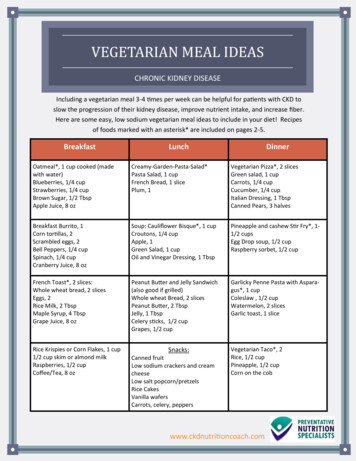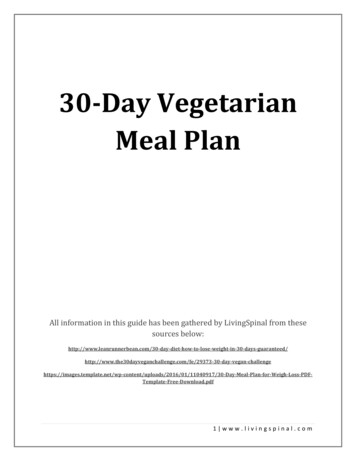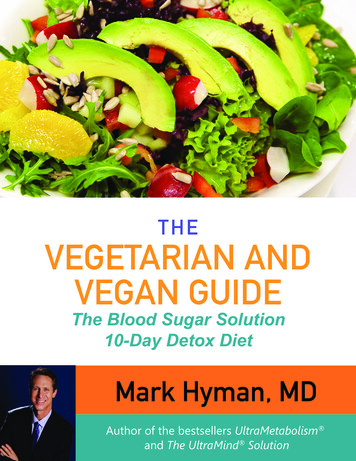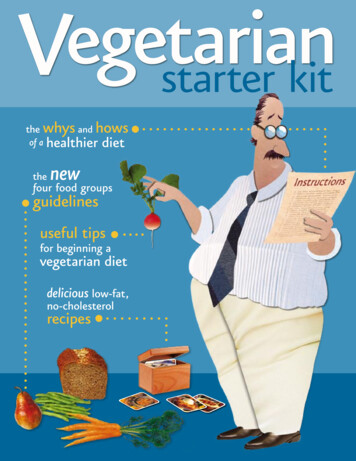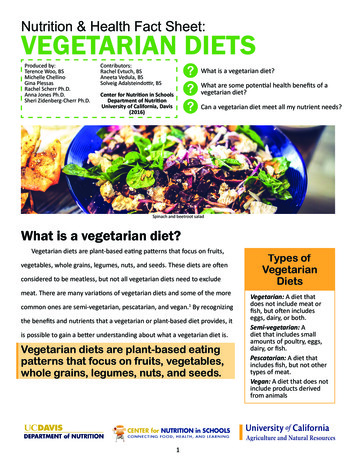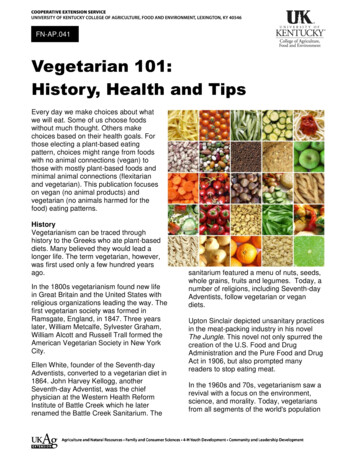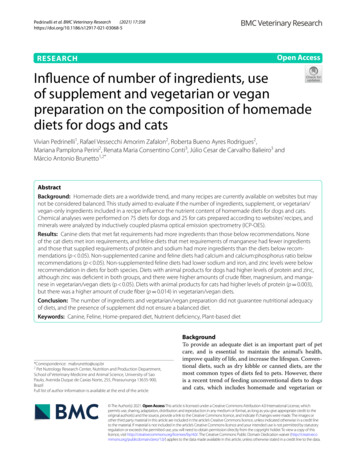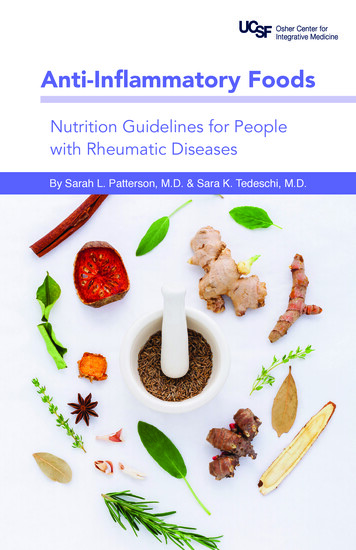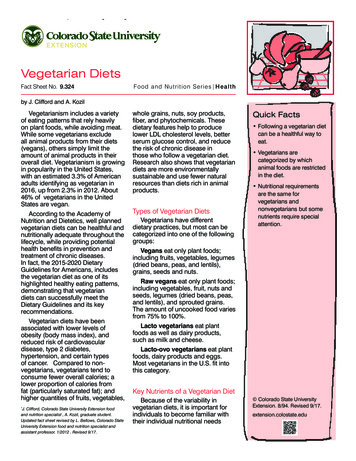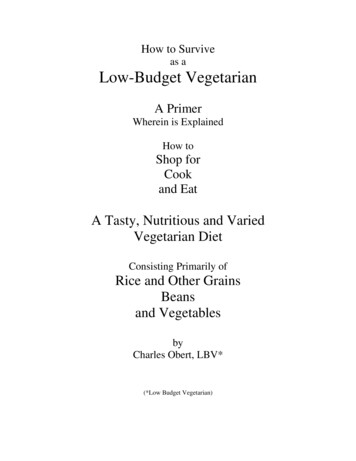
Transcription
How to Surviveas aLow-Budget VegetarianA PrimerWherein is ExplainedHow toShop forCookand EatA Tasty, Nutritious and VariedVegetarian DietConsisting Primarily ofRice and Other GrainsBeansand VegetablesbyCharles Obert, LBV*(*Low Budget Vegetarian)
Copyright 2003,2004 Charles Obert. All Rights ReservedFirst Edition May 2003Second Revised Edition June 2004Dedication:To EveA fine vegetarian cook,and a Master Japanese ChefDear Gentle Reader,I have a web site related to the book. The url is either www.lbveg.com orwww.lowbudgetvegetarian.com . Please visit me there to keep in touch with new developmentsin my experiment in Low Budget Vegetarian cooking.On my website you will also find some additional free recipes for downloading.This is the second, revised edition. Along with correcting some errors, I also rearranged some ofthe material, and provided more cross-references to make the book easier and more practical touse.I very much welcome your comments, suggestions and feedback. There is a comments andfeedback page on the web site, or you can reach me through my snail-mail address below.I hope the book is useful to you. Enjoy.Regards,Charlie Obert“Pardon my freedom.”Charles Obert3507 Taylor Street NEMinneapolis, MN 55418-1326
Table of ContentsTable of ContentsPREFACE - PLEASE READ THIS FIRST5THE BASICS - SHOPPING, MEAL PLANNING, COOKING8ON GRAINS, BEANS, PROTEIN AND BALANCEWEEKLY MEAL PLANNING AND BACKGROUND COOKINGGENERAL GUIDELINES FOR EFFECTIVE SHOPPINGONE, TWO AND THREE DISH MEALSLUNCH AND SNACK IDEASBASIC COOKWARETIPS FOR TASTY COOKINGVARYING LEFTOVERSADAPTING RECIPES THAT USE MEATCOOKING FOR THE SEASONSCOOKBOOKSMAIL ORDER AND INTERNET SOURCES8910141516161818192021BASIC INGREDIENTS AND COOKING INSTRUCTIONS23GRAINSRICEGRAIN COOKING DIRECTIONSBEANSMAKING BEANS EASY TO DIGESTBEAN COOKINGVEGETABLESTHE PROBLEM OF FRESH GREENSOILSINVISIBLE SEAWEEDON USING CHILISCONVENIENCE FOODS AND CONDIMENTSTEAS AND BEVERAGES23232526283031333435363738BASIC RECIPE PATTERNS - FRAMEWORKS FOR CREATIVITY39BASIC RICE AND VEGGIES RECIPE PATTERNEXAMPLE GRAIN AND VEGETABLES RECIPESALL PURPOSE RICE (GRAIN) SALAD PATTERNBASIC SALAD DRESSINGSBASIC BEAN STEW OR DAL RECIPE PATTERNSAMPLE BEAN RECIPES394041414343SPICE AND CONDIMENT PATTERNS - THE KEY TO VARIETY OF TASTE441
Table of ContentsBASIC PLAINRECIPES USING BASIC SPICE PATTERNINDIAN - THE USUAL SPICESRECIPES USING ‘THE USUAL’ INDIAN SPICESWARMING SPICESRECIPES USING WARMING SPICESMEDITERRANEANRECIPES USING MEDITERRANEAN SPICESSAVORYRECIPES USING SAVORY SPICESORIENTALRECIPES USING ORIENTAL SPICESMEXICANRECIPES USING MEXICAN SPICES4445454646464647474748484848SAMPLE RECIPES49NOTES ON THE RECIPESGRAIN DISHESRICE AND VEGETABLES WITH DICED TOMATOESRICE AND VEGETABLES ‘MEXICANO’RICE WITH PINTO BEANS AND VEGETABLESAFGHANI BASMATI RICE WITH RAISINS AND CARROTSWHITE RICE AND MOONG DALLINGUINE WITH SPINACHEGG NOODLES WITH TEMPEH AND VEGGIESSOBA NOODLES AND VEGETABLESNOODLES WITH MOCK DUCK AND ONIONSSPICY CREAM OF WHEATBULGHUR WITH VEGETABLESRICE AND BULGHUR WITH VEGETABLESBAKED STEEL CUT OATS WITH RAISINS AND PEANUTSBAKED STEEL CUT OATS AND VEGETABLESQUINOA PATTIESQUINOA CASSEROLEBEAN DISHESGREEK SPLIT PEA SOUPYELLOW SPLIT PEA SOUPRED LENTIL SOUPMOONG DALSIMPLE BLACKEYED PEASLENTIL STEWLENTIL TOMATO BEET STEWMEXICAN BLACK BEAN SOUPBLACK BEANS WITH POTATOES AND CHILISBLACK BEAN CHILICHICKPEA RED LENTIL STEWMEDITERRANEAN BEANS AND VEGETABLESDIPS AND RELISHESLENTIL DIP WITH ONION 62626364646566666768682
Table of ContentsHUMMUS TAHINI (CHICKPEA DIP)CHICKPEA OR SOYBEAN DIPTOFU-DILL DIP WITH VARIATIONSADUKI BEAN GINGER DIPSTEAMED EGGPLANT DIPONION RELISHSALADSRICE AND VEGETABLE SALAD SAMPLECARIBBEAN SALAD WITH CHICKPEASTABOULI SALADCHICKPEA RICE SALADPOTATO SALAD WITH CHICKPEASPRESSED CABBAGE SALADSPICY CABBAGE SALADCREAMY COLESLAWCOOKED VEGETABLEPOTATOES WITH BROWN MUSTARD SEEDSCOOKED SPICY CABBAGETOFU AND SPINACHSAUTEED SQUASH WITH ONIONS AND SPICESOVEN ROASTED VEGETABLESSOUPS (NOT BEAN BASED)MISO VEGETABLE SOUPARTSY BUTTERNUT SQUASH ALMOND BUTTER SOUPCREAMY PARSNIP OAT SOUPVEGETABLE TOMATO BARLEY SOUPSAUCESSERIOUS TOMATO SAUCESPAGHETTI AND MOCK DUCK WITH (OR WITHOUT) TOMATO SAUCEONION MISO 8181828384848586
Table of Contents4
PrefacePreface - Please Read This FirstI want to talk about what I am trying to do with this little book, and how to get the most out of it.This is to encourage you to read and use all of the book, and to resist the temptation to skip overthe first part of the book to get at the recipes.There seems to be a prevailing popular myth in our culture that eating a diet with little or no meator dairy products is difficult, or boring, or expensive, and that it takes a lot more time and effortto ‘replace’ animal food in a healthy diet.I find the opposite to be true, and this book is written to give you the basic knowledge and toolsyou need to have a diet that is primarily or completely based on grains, vegetables and beans, thatis nutritious, interesting, and inexpensive, and that takes no more cooking effort that you wouldneed for a healthy meat-based diet.Grains, vegetables and beans, taken together, make up the core of the traditional diets of mostpeople around the world for most of our history on our planet. They are the core foods that I talkabout preparing in this book.For those of you who have concerns about digestibility of beans, I have an extensive section onmaking beans easy to digest, in which I pull together cooking techniques and digestive aid spicesfrom different cuisines.This cookbook is not intended primarily as a collection of recipes. It is designed to teach you howto naturally think and cook like a vegetarian. In our culture especially, I find that most peoplehave a hard time thinking of planning meals that aren’t built around a meat dish. So, people whoare new to vegetarian cooking often think in terms of replacing the meat, rather than thinking ofhow to use grains, beans and vegetables for what they do well in their own right.I will cover the following main topics where and how to buy these main foods in a way that is inexpensive but still gives you goodquality food how to cook and combine these foods in such a way that they are interesting, tasty and easilydigestible proportions of foods that make for a balanced and satisfying eating experience separate chapters on cooking grains, on beans and peas, and on salads how to cook ahead while still varying foods so you can deal with lunches and preparingworkday meals ahead of time how to use a few basic spice patterns to vary taste.Opening SectionThe opening sections of this book cover the basic skills of meal planning, shopping and cookingthat you will need. They are intended to give you basic ways to prepare grains, vegetables andbeans that apply to a wide variety of recipes.5
PrefaceSpice PatternsThe section on spice patterns is one of the most important and useful parts of the book. These aredifferent combinations of spices that go well together. This provides a framework you can use toimprovise and create your own recipes with confidence. I have organized them around the mostcommon spices used in different vegetarian traditions from around the world, including Indian,Middle Eastern and Mexican. Once you get a handle on these, you can take the same basic grainsand vegetables, and cook and Indian style meal one night, and a Mexican meal the next.Master these patterns and you will never, ever get tired of cooking with grains, beans andvegetables.In each of the sections on spice patterns I include a list of the recipes that use that particularpattern, so you can learn by example.Recipe Patterns or TemplatesIf you use many cookbooks at all - which I have, over the past 30 years - you will start to noticethat even cookbooks that look like they have hundreds of recipes, actually have only a handful ofrecipe patterns, with some variants on the ingredients. Once you really understand a recipepattern, you have the ability to take similar ingredients and come up with your own individualvariants, your own recipes. Do enough cooking and you will develop your own personal cook’sinstinct, that guides you to what mix of ingredients and spices feels right for this particular meal.That’s where you start really being a vegetarian cook.There are three basic kinds of recipe patterns that I cover in this section. Rice (or other grain) with vegetables and/or beans Bean stews, soups or dals (Dal sounds trendier than pea soup) cold Rice (or other grain) and Vegetable saladsMaster these three patterns and you master the core of main-course vegetarian cooking.The RecipesThe recipes in this book are intended primarily as rough guides, examples of how the spices andother ingredients work well together. You can use them as-is, and you can use them as startingpoints for your own creativity. The recipes all reference which ethnic spice pattern they use, tohelp you get comfortable with them.Simple Daily CookingThis is not primarily a book on creating elaborate feasts or gourmet meals to entertain andimpress friends with, although you can certainly use these cooking techniques to do that if youwish. These are the kinds of meals I cook day in and day out, week after week. This is what mywife and I live off of.What I want to cover is simple and easy to prepare one-dish and two-dish meals that you can liveon and enjoy. Simple enough to be do-able, varied enough to be tasty and enjoyable. That’s why Icover just a few basic techniques that have a lot of room for variation without needing a lot ofwork.6
PrefaceNot About Replacing MeatThis book is not an attempt to produce imitation meat kinds of foods. Vegetable based burgersand meat substitutes are fun as a change of pace, but they are too expensive to serve as primaryfoods. I cover simple ways of cooking that let grains, vegetables and beans do what they do best,rather than trying to imitate something else.(Optional) New Foods From Different CountriesIn the recipes, I introduce a lot of food choices from different cuisines, primarily from India, FarEast Asia, the Mediterranean, and Mexico. Unlike our regular American cooking, these cultureshave highly developed vegetarian cuisines, and it only makes sense to use them.A lot of these foods are becoming easily available in markets in larger cities, and I providesources for mail or internet order if you don’t have easy access to stores that stock these foods.While use of foods from different cultures definitely increases the variety of your diet, they arenot necessary to use the skills and recipes in this book. For most of the recipes that use out of theordinary ingredients, I provide suggestions for substitutions.Not a Comprehensive CookbookFor space reasons, while this book does not cover all of the basic ways of cooking, I do provideenough information to prepare all the recipes and patterns I cover. I don’t spend a lot of time onplain vegetable side dishes, since I usually prepare meals with the vegetables cooked in togetherwith the grains or beans, and that is how I cover them here. I include a list of cookbooks that Ifind helpful and interesting.If you look through the list of recipes, you will see that I concentrate on grain and vegetablecombination dishes, and on various bean dishes, since these form the core of the main-coursefood that makes up a satisfying vegetarian diet.7
The BasicsThe Basics - Shopping, Meal Planning, CookingOn Grains, Beans, Protein and BalanceThe core of a satisfying vegetable-based diet is a balance of grains, beans and vegetables. This istrue whether or not you include any eggs or dairy products. It also works well even if you stilldecide to eat some meat or fish. In my experience, I would roughly estimate the proportions ofthese foods in a satisfying diet as follows:Grains - about 40% to 50%Vegetables - about 30% to 50%Beans - about 10% to 20%Everything Else (fruit, dairy products, nuts, desserts) - maybe 10%A meat-based diet is anchored or built around the meat dish. That provides the center of the meal,and the rest of the meal is usually built to complement it.In a vegetable-based diet, your grains and beans together form the hearty center of the diet. Theyare the dense and satisfying parts of the meal. If you try to eat too high a proportion of justvegetables without grains and beans, your meals will be unsatisfying and leave you feelinghungry and often ungrounded, spacey.Your vegetables provide a lot of the variety of texture, color and taste. A diet without sufficientvegetables, with just grains and beans, is monotonous and unsatisfying in texture, and will leaveyou feeling stuffed and sluggish.Get the proportions of these about right and you will have a diet that is nutritious, satisfying, thatsits well and is easy to digest, and that leaves you feeling energetic and balanced. Also, thesethree together will give you a diet as simple, or as wildly varied, as you care to make it.I have also found that grain, bean and vegetable-based meals leave me feeling centered, balanced.Eat these foods enough and you will develop your own intuitive sense of meal balancing. This isuseful, because if you have a sense of what it feels like to be centered and balanced, you willrecognize it when you get off-balance. It’s not much fun binging on sweet donuts and coffee onceyou recognize how off-balance you feel afterwards. Develop that feel for balance and your dietwill become increasingly self-regulating. It just plain old feels better, and tastes better, to eathealthy and balanced meals.About ProteinFrancis Moore Lappe, in Diet for a Small Planet, popularized the concept of proteincomplementarity. Basically, with few exceptions, neither grains or beans by themselves arebalanced and complete sources of protein. However, grains and beans complement and completeeach other, so that these two foods eaten together provide complete and high quality protein.The optimal proportion of grain to bean for best protein balance is around 3 to 1 or 4 to 1.Interestingly, I have found that this is about the proportion that these foods seem to digest thebest.8
The BasicsA small amount of animal food - a little bit of cheese or yogurt, or egg - also complements grainprotein.I have for me that having at least one good protein-balanced meal a day seems to provide morethan enough protein. However, I have found that some form of grain is necessary at pretty muchevery meal for the meal to feel satisfying and balanced.Weekly Meal Planning and Background CookingNeed for planningCooking economically, nutritiously and tastily takes some weekly thought and planning to pulloff successfully. Being able to cook quickly and economically means thinking ahead to make sureyou have good ingredients readily available to be able to put together a quick meal, and somealready prepared dishes to use.Not planning your dinner meal until an hour before does not encourage creativity andspontaneity. Instead it limits your choices to what you have on hand. If you don’t take the timeto think ahead you will find yourself being tempted to have pre-cooked convenience dinnerssitting around, and they are not economical for money, for nutrition, or for taste. Or, moreexpensive yet, faced with a time pressure to cook and lack of good foods to cook with, you willbe tempted to do take out, eat out, or home-delivery. That is not an efficient use of your fooddollar.Thinking and Planning WeeklyA week seems to be about the right unit of time to for making a general meal plan. I use theweekend to think out meals - with the general plan in place before I go shopping and not after! then to do the shopping and major cooking.Bean dishes, stews and soups lend themselves to being cooked in advance, and some stews tastebest on the second or third day. Grain salads for lunches, and some cabbage based vegetablesalads, can also be prepared in large batches ahead of time.Grains cook quickly enough that they can be cooked plain, in batches good for 2 or 3 daysmaximum, then kept on hand to combine with vegetables and other foods for quick dinners.When you have main bean and grain dishes chosen as the framework for your week’s meals, theone other thing you need is to have enough good quality vegetables around to quickly turn thosegrains and beans in to tasty and varied meals.Shopping WeeklyIn your main weekly shopping trip, your task is to get the foods and spices you need for theweek’s general meal plan.Good quality fresh vegetables are the key ingredients to have around to make the meals work.You will probably have a combination of the main vegetables you always have around - thingslike onions, carrots, celery and such - combined with other veggies that vary by week or byseason, according to what looks good at the market that day. You may end up building one ormore meals around a vegetable that looked especially good that week.9
The BasicsBecause good quality vegetables are so important to making meals work, I suggest that you makeyour main market for your weekly shopping run, the best source for good, fresh produce you canfind.Background CookingPreparing bean and vegetable based main-course stews and soups is a slow and time-consumingprocess, but it does not need to consume your time. With a little bit of forethought, it takes verylittle time and effort on your part, and the cooking can go on untended while you get on with therest of your life. Many of the these foods can be prepared with methods of cooking that requirelittle or no effort on your part.Pre-soaking beans is a matter of washing them, putting them in water and letting them sit, all dayor all night.Cooking bean-based dishes like stews usually takes a little bit of work up front to assemble theingredients, and then you can just let them alone to sit and cook. At the end of cooking time thereis sometimes a little bit of work finishing up and adding final ingredients.Slow cookers are wonderful for unattended background cooking, and bean based dishes get alongwell with slow cooking. Also, plain beans can be cooked completely unattended in a slow cooker.Beans freeze well, so it is a good idea to prepare a batch of beans and then freeze them in bagswith the portion size you will want to cook with.Summary - Here is the method I use to plan a week’s meals. First, plan the main bean and vegetable stew dish, and/or maybe your grain based salad.Block out a very rough idea of meal plans for the week. Do the main shopping for the week, allowing for variation depending on what produce looksgood. Get your big batch stew or grain salad prepared, and maybe prepare some plain beans tofreeze, or as ingredients to mix in fresh dishes. Have enough grains cooked for 1-2 daysahead. Do as much background cooking as you can. Plan your meals for the week, taking into account the life-span of the vegetables you bought.Light green salads and dishes with perishable vegetables can be done earlier in the week, andthe later meals can use more durable vegetables. Allow for a couple of easy to prepare change-of-pace dinners in the middle of the week usingconvenient on-hand ingredients. As the week wears on, perk up your leftover salads and stews with a bit stronger seasoning orextra garnishes.General Guidelines for Effective ShoppingAll of these guidelines are areas that I have learned by making mistakes. Hopefully they will saveyou time and money.Shop low on the food processing chain. This means you are avoiding processed or precookedfoods.10
The BasicsBuy whole and uncooked dry grains and beans. Regardless of where you shop these are the mosteconomical foods you can buy. The same with vegetables - go for whole uncooked vegetables.Even with convenience foods to keep around for quick meals, it is worth going for minimallyprocessed. I like to keep canned beans and frozen vegetables around for quick meals, but I buythem plain, without prepared seasonings or sauces. They are most economical this way, and theygive you a lot of flexibility in ways to use them.This also means generally avoiding most substitute animal or dairy products, things likesoyburgers, tofu hot dogs or vegan ice cream. They may be fun as an occasional indulgence, butthey are not an efficient use of your food dollar. The one exception I use regularly is good qualitysoy or rice milk, which can be used in place of regular milk over cereals and in cooking.Avoid buying empty foods. When you are trying to make every food dollar count, you reallycan’t afford to spend a lot of money on food that is there just for taste or to fill up space withoutproviding good nutritional value. This includes most pre-made soups and sauces.Buy only high-quality ingredients. Shopping for food bargains is a good buy only if the food isnutritious and tasty to eat.On the one hand, if a food is not nutritious, it is just taking up calories and space in your diet, andwill probably leave you still wanting to eat more. On the other hand, if it doesn’t taste good youprobably won’t get around to eating it.Good quality oils are some of the more expensive food items that you will buy regularly.However, the difference they make in the taste and quality of the dishes you prepare with them isenormous, and the amount of oil you use per dish is generally not that large so that a jar of oilgoes a pretty long way.Buy organic as much as you can afford. Sometimes organic food is more expensive than itsconventionally grown counterpart, but it really is a better value because it is better quality. Thisseems to be especially important with produce. Organically grown vegetables and fruits areconsistently better and more vivid tasting than conventionally grown. Some conventionally grownproduce seems to be produced for visual appeal or long shelf life, but has very little flavor. If youwant to experiment for yourself, take a common food like onions, and cook with a conventionalbatch one week, and with an organic batch the next. See if you can tell the difference.Buy mainly vegetables that have a good storage life, and store them correctly.It’s not much good buying high-quality organic vegetables if they sit and rot at the bottom of yourrefrigerator. If your are buying something like delicate greens, plan your meals so that you getaround to eating them within a day or two.Make plans to actually cook and use the foods you buy. I can’t tell you how many cans andbags of miscellaneous food stuff I have accumulated over the years that has floated to the back ofmy pantry because I never got around to cooking with it, or how many wonderful fresh veggieshave turned into mutants in my fridge because I never planned them into a meal.Check out your local ethnic groceries for good quality foods at good prices. There arecuisines from all over the world that have highly developed traditional vegetarian foods and waysof preparing them, using all kinds of wonderful grains, beans and vegetables. It only makes senseto take advantage of them.11
The BasicsIf you buy a food in a store where it is considered exotic or a trendy luxury, you will pay luxuryprices. If you buy a food in a store where it is a regular part of the diet, you pay everyday prices.When you can, buy foods at stores where that food is a basic part of that community’s diet.For example, if you are going to make rice a big part of your diet, it makes sense to check out thegroceries that cater to communities who already use a lot of rice as part of their regular diet. Thatincludes Far East Asian (Japanese, Korean, Chinese, Vietnamese, Thai), Indian, Middle Eastern,Mexican. Each type of store will have the kinds of rice that community uses. You can samplesmall bags of different kinds and then go buy in bulk with the kind you really like.When you do check out foods like this, be sure to compare prices and to check the quality bytrying a small amount. Do not assume that food quality is either better or worse, or that prices arebetter or worse, because you are in an ethnic grocery.Similarly, (and sadly,) do not assume that food is higher quality because it is an expensivespecialty item in a natural foods store or co-op. Vegetarian food is very trendy these days, andthere are a lot of overpriced specialty and processed items on the shelves of natural foods storesand even of co-ops. Don’t be hypnotized by the Natural Foods Mystique. Cheese isn’t better justbecause it’s unpronounceable and imported.For those of you who have limited or no access to the kinds of stores I am referring to, I amincluding a list of mail order or internet order sites in an appendix.Buy in reasonable bulk - Once you know what kinds of rice, grains and beans you prefer, andabout how often you use them, you can often get better prices if you buy in bulk. These are driedfoods with very long shelf life, at least a year or two.With spices, buy in reasonable bulk and avoid buying in little jars or cans - It is unfortunate,but supermarkets are about the worst places to buy spices for value and economy. You payridiculous prices for those little jars and cans.Fortunately, many other stores have spices available in reasonable bulk at much lower prices - coops, some natural food stores, and most ethnic markets I have seen are examples. There are alsogood mail order and internet order sources for quality spices, and these are cost-effective to use ifyou plan your buying so that spice value offsets shipping cost.What to Buy WhereThis is a list of some different kinds of markets, and some basic foods you can find there that areespecially good food value and variety. These lists are not meant to be comprehensive, nor dothey do justice to the wide variety of foods available in their cuisines. These are foods that I useall the time and that are not particularly exotic or weird tasting to most people.Since quality of fresh produce varies wildly from market to market, the lists include mainly driedand canned foods and spices. I encourage you to check out any ethnic groceries in your town orcity to see what their produce section is like, since you may find some very good selection andvalue.12
The BasicsIndian (Asian)basmati riceteasbeans, peas, dalsspicesMiddle Easternbasmati ricebulghur (cracked wheat)teasdried beanspita breadolive & sesame oilcanned fava beansspicesdried dates and figsOriental (Chinese etc.)rice - all kinds!mock duck (wheat gluten)good-tasting greenssome dried beansteas, esp. green, oolongfresh basilmiso, soy saucesea vegetables (kombu)dried and canned beansspices (oregano, epazote)Mexicanchilis, fresh and driedlong grain white riceOriental markets are rice heaven. You can get short grain, medium grain, long grain, white riceand brown rice. The short grain rice I find at oriental markets is my personal favorite for versatilemain grain. Mock duck or wheat gluten is available in small cans at good prices, and it tastesbetter than the pricey luxury kind you find in natural foods stores. Miso and soy sauce are saltyfermented condiments widely used in Asian cooking. Those oriental markets that have good freshproduce sections often have wonderful selections of green leafy vegetables that cook up quicklyand taste wonderful. You can also sometimes find fresh basil at a fraction of the price that regularsupermarkets charge.Indian markets - Beans and peas are a regular part of their cuisine, and they have the mostextensive and varied spice repertoire on the planet. Since they use spices so extensively theirprices are usually very reasonable. They also have basmati rice at very good prices since it is theirmain grain.Middle Eastern markets are good sources for basmati and other rices, for many spices, and forsome dried beans and peas. You can also find bulghur or cracked wheat, and couscous which isanother kind of wheat product. Canned fava beans are a good and economical convenience food.Some middle eastern markets also have good varieties of inexpensive black teas.Mexican markets - the little Mexican super-mercado near me has about a third of one walldevoted to different kinds of dried chilis, ranging in hotness from mild to incendiary. The othertwo-thirds of that wall is covered by inexpensive bags of all different kinds of spices. Along withlong grain white rice, and dried and canned beans, some Mexican markets have good freshproduce sections, with fresh chilis and various common and uncommon vegetables.13
The BasicsOne, Two and Three Dish MealsThe meals plans that I find satisfying follow simple patterns. These are the kind of meals that Ican sit down to and eat a satisfying amount without the need to stuff myself, then get up and beable to go for some hours without feeling hungry or having the need to compulsively munch.They feel balanced to eat, and I feel balanced after I eat them.Meals built around grains and vegetables, often complemented with beans, provide a satisfyingeating experience. I like to have the grain be the largest part of the meal, with the proportion ofgrains to beans at least 3 to 1. These three foods together make up over 80% of my diet, with theother 20% devoted to Everything Else.For meal planning purposes I divide them into one dish, two dish, and three dish meals.One dish meals that I serve are almost invariably grain based, most often with rice, usually incombination with other ingredients including vegetables and beans or bean-based foods.Some types of one dish meals include rice and vegetables, sometimes including a complementary food like beans, tofu or tempeh,or mock duck. This works for breakfast, lunch or dinner, and can be made endlessly variedby changing the spices or complementary vegetables, using more or less oil, cooking dry withjust oil or wet with tomatoes or a sauce, and so on. cooked bulghur with vegetables - like the above. cooked pasta, either stirred up with sauteed vegetables, or with a thick sauce or stew thatincludes vegetables. Some t
table of contents 3 hummus tahini (chickpea dip) 68 chickpea or soybean dip 69 tofu-dill dip with variations 70 aduki bean ginger dip 71 steamed eggplant dip 71 onion relish 71 salads 73 rice and vegetable salad sample 73 caribbean salad with chickpeas 73 tabouli salad 74 chickpea rice salad 74 potato salad with chickpeas 75 pressed cabbage salad 76 spicy cabbage salad 76 creamy coleslaw 77
